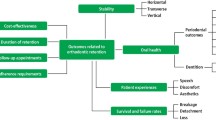Abstract
Design
Three arm, parallel group, patient randomised trial.
Intervention
Seventy-five patients who had just completed a course of treatment with four premolar extractions and fixed straight wire appliances in both jaws (0.022 inch, MBT) having had no previous orthodontics, were randomised by participant ballot sampling. To be eligible they had to be in the permanent dentition, with space deficiencies in both jaws, normal skeletal and dentoalveolar sagittal, vertical and transverse relationships, Class I molars or 3mm anterior or posterior deviation. The three retention methods were: 1) removable vacuum-formed retainer with maxillary canine-to-canine and palatal coverage plus a mandibular canine-to-canine bonded retainer (GroupV-CTC); 2) an identical maxillary vacuum-formed retainer as in Group V-CTC plus stripping of mandibular anterior teeth (Group V-S); and 3) a prefabricated positioner covering all erupted teeth in both jaws (Group P). Patients were given appliances within one hour of debonding, which were worn more for the first than second year then discontinued.
Outcome measure
Dental casts were taken at four time points; before treatment, on removal of fixed appliances, after 12 months and 24 months of retention. Twenty randomly selected casts were measured by a single blinded assessor on two separate occasions, four weeks apart, using electronic digital callipers for inter-canine width; inter-molar width; arch length; overjet; and overbite. Height and estimated compliance was recorded at every visit. Successful retention using Little's Irregularity Index was considered to be <3.5mm.
Results
Seventy-five patients were enrolled, and 69 completed, the trial. The mean active treatment time was 1.7 years and mean age was 14.4 years (SD 1.5) at start of retention. Although there were statistically significant differences for some of the parameters measured, there were no clinically significant differences between the three retention methods. All three were equally effective in retaining orthodontic treatment results and controlling relapse to a clinically significant level even when the results were adjusted for cooperation, initial crowding, growth and gender. The major part of relapse took place during the first year of retention.
Conclusions
All three retention methods, V-CTC, V-S and P, retained the orthodontic treatment results and prevented relapse within clinically acceptable levels. Most relapse took place within the first year of retention and changes during the second year were small or negligible.
Similar content being viewed by others
Commentary
Maintenance of orthodontic treatment stability is a much debated subject. The plethora of appliance designs, modifications and adjunctive techniques in use, along with a range of advice given by clinicians, demonstrates the lack of consensus within the specialty.
A Cochrane Systematic Review1 outlined the requirement for high quality research in this area. The brief was followed closely in this randomised controlled trial comparing three orthodontic retention methods over a two-year period for patients who had undergone routine orthodontic treatment in a publically funded Swedish orthodontic clinic.
The trial was reported in remarkable detail with clear methodology and trial design, with the inclusion of a Consort diagram further simplifying probity. Considerable effort was made to demonstrate the homogeneity of the groups and this was successful. The use of ballot randomisation seems a little dated and could have introduced some selection bias, although there is little evidence this affected the results.
The authors used Little's Irregularity Index2 (LII) as the primary outcome measure. The linear displacement of anatomic contact points, canine to canine, is measured using this method. The sum of the five displacements gives a measure of anterior irregularity. Clinical significance was determined as a cumulative difference of 2.0mm.
However, it is difficult to determine clinical significance using this index as four contact point displacements of 0.5mm may not be discernable to a patient, but one displacement of 1.5mm certainly would and may well be the focus of dissatisfaction for a patient. This outlines a limitation in researching this area. Although this study shows there is no significant difference in outcome between the three modes of retention investigated in this trial, the clinical success of these modes cannot be determined. If success is patient satisfaction, should this be our primary outcome?
Interestingly, the authors discussed that five patients lost their vacuum formed retainers and had them replaced, and three required rebonding of bonded retainers. These complications had no significant influence on the outcome of retention. This trial seems to indicate that co-operation is the key to successful retention regimes rather than the specific mode of retention.
This trial successfully brings quality data into this area of research, which could be combined with other trials to start providing us with evidence to back up retention choices we make for our patients.
References
Littlewood SJ, Millett DT, Doubleday B, Bearn DR, Worthington HV . Retention procedures for stabilizing tooth position after treatment with orthodontic braces. Cochrane Database Syst Rev 2006; 25: CD002283.
Little RM . The Irregularity Index: a quantitive score of mandibular anterior alignment. Am J Orthod 1975; 68: 554–63.
Author information
Authors and Affiliations
Additional information
Address for correspondence: Department of Orthodontics, University of Malmo, Malmo, Sweden. E-mail: gudrunedmantynelius@gmail.com
Edman Tynelius G, Bondemark L, Lilja-Karlander E. A randomized controlled trial of three orthodontic retention methods in class I four premolar extraction cases – stability after 2 years in retention. Orthod Craniofac Res 2013; 16: 105–115.
Rights and permissions
About this article
Cite this article
Walker, M. No differences seen in outcomes between three different methods of orthodontic retention. Evid Based Dent 14, 81–82 (2013). https://doi.org/10.1038/sj.ebd.6400951
Published:
Issue Date:
DOI: https://doi.org/10.1038/sj.ebd.6400951



